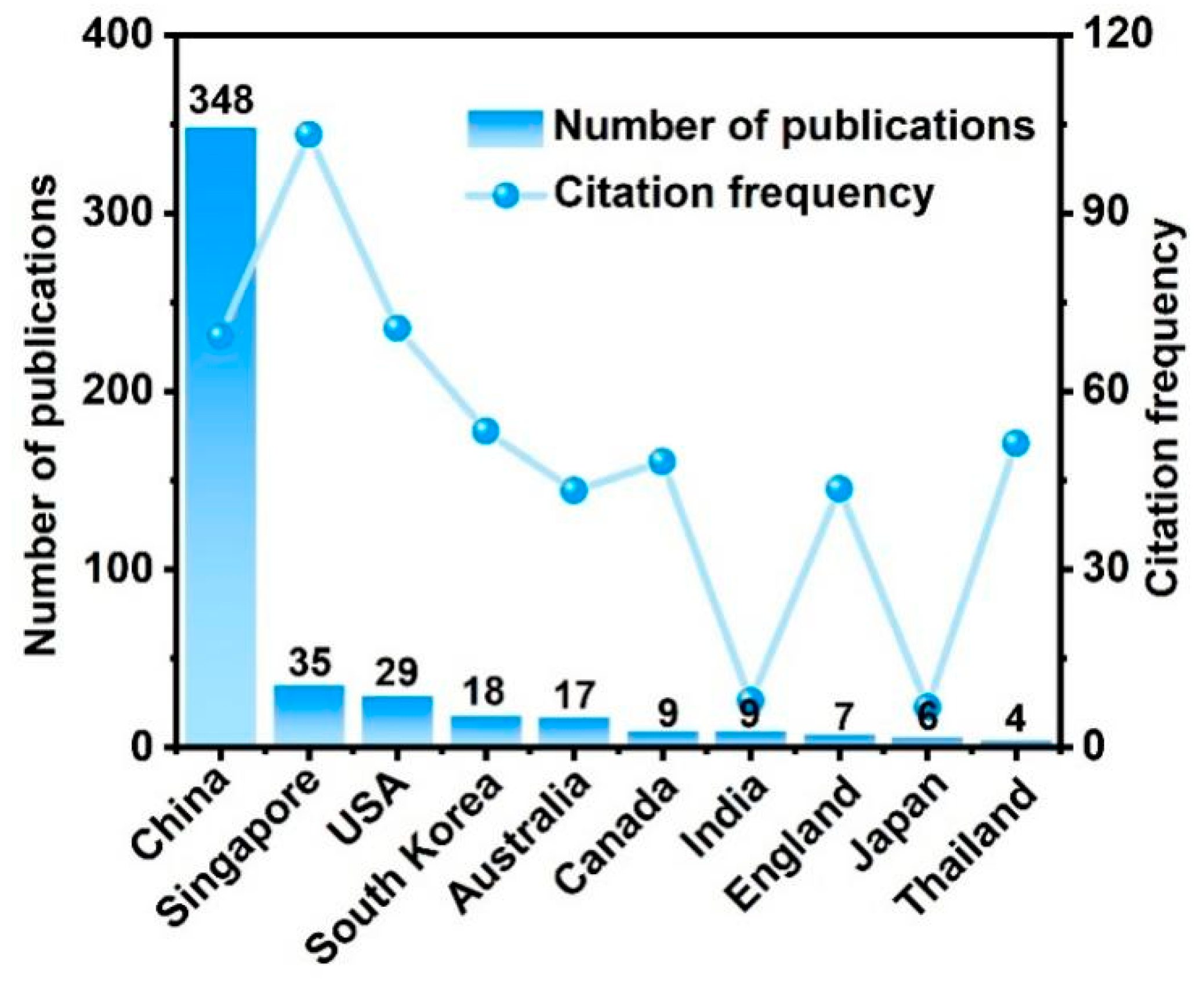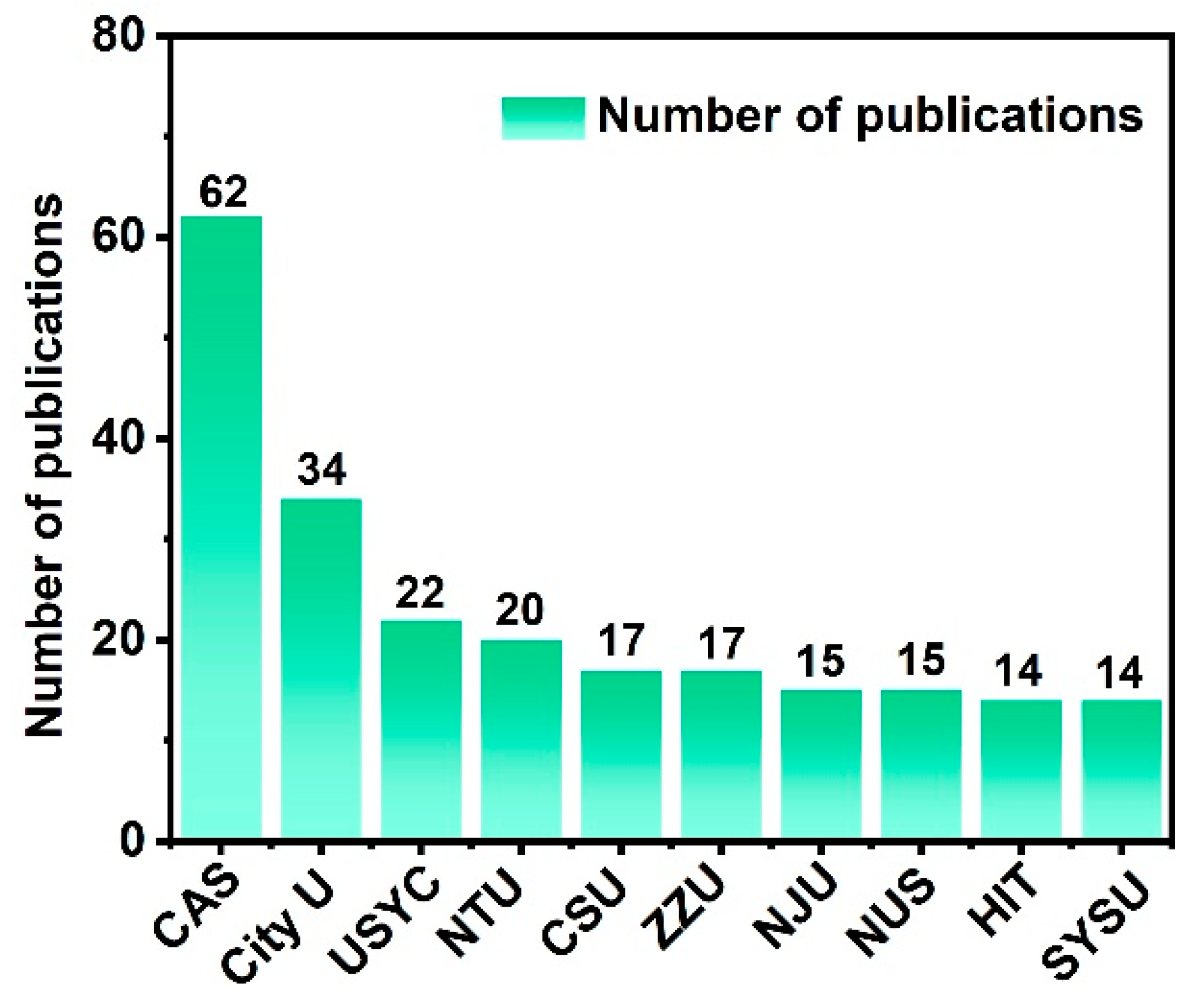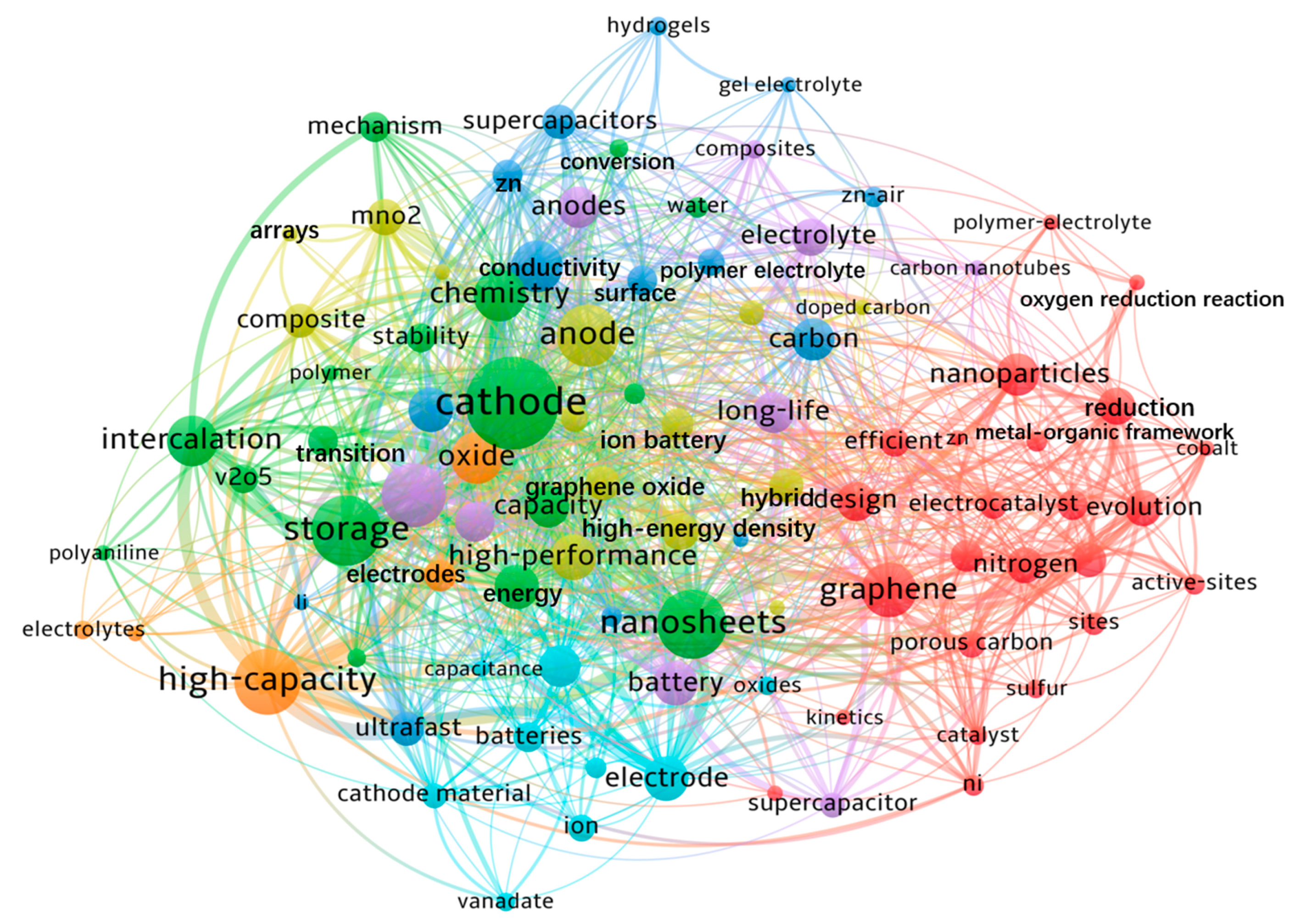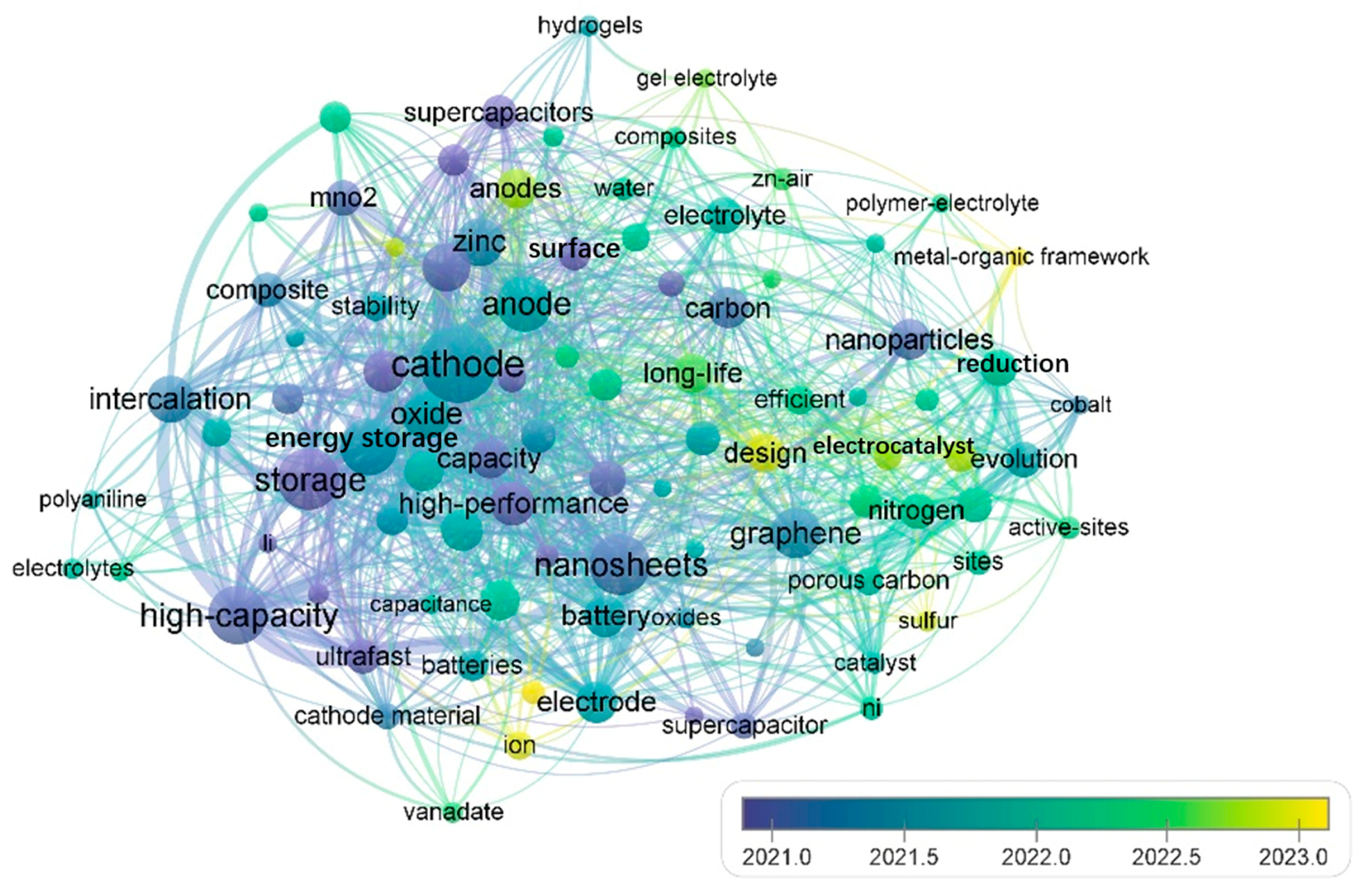1. Introduction
The global transition toward renewable energy systems has increased the demand for sustainable, safe, and high-performance energy storage technologies [
1]. Although lithium-ion batteries dominate current markets, their limitations—including lithium resource scarcity, safety risks from flammable organic liquid electrolytes, and environmental concerns—have spurred interest in alternative solutions among researchers [
2]. Among emerging candidates, aqueous zinc-ion batteries (AZIBs) stand out due to their inherent safety, low cost, and high theoretical capacity (820 mAh g
−1 for Zn metal) [
3]. However, traditional aqueous zinc-ion batteries (AZIBs) face critical challenges, such as zinc dendrite growth, hydrogen evolution reactions (HERs), and cathode dissolution, which degrade cycle stability and energy density [
4]. While solid-state systems eliminate safety risks, their rigid interfaces limit ionic conductivity and electrode kinetics. Conversely, quasi-solid aqueous zinc batteries (QSAZBs) strike an optimal balance: hydrogel/composite electrolytes (1) suppress dendrites via mechanical confinement, (2) minimize HERs by reducing water activity, and (3) retain high ionic conductivity while enabling flexibility for wearable applications [
5,
6,
7,
8]. This positions QSAZBs as pivotal for grid-scale and portable storage. Recent studies demonstrate breakthroughs in flexible QSAZBs for use in wearable electronics and grid-scale storage, yet a holistic understanding of global research trends and knowledge gaps remains lacking.
Some research papers and reviews have reported the development, application, and future directions of QSAZBs [
9,
10,
11]. For example, Wang et al. reviewed the design principles, functionalization strategies, and applications for QSAZBs [
11]. Despite prolific research output in this field, existing reviews predominantly focus on experimental advancements, with limited synthesis of global research trends, interdisciplinary connections, or knowledge gaps. Existing reviews primarily focus on experimental advancements in materials or device engineering, neglecting quantitative insights into publication patterns, collaboration networks, or technological forecasting. Bibliometric analysis, a quantitative tool combining mathematics and statistics, offers a powerful lens to decode the evolution of QSAZB research. Integrating bibliometric analysis into the review of QSAZB research, which can produce a visual analysis of the field, would help researchers grasp an overview of the subject of QSAZBs, determine areas of interdisciplinary and collaborative research, and promote the development of the subject [
12]. To the best of our knowledge, an overview of the research trends in the QSAZB field has not been reported.
Bibliometric analysis is a method that uses mathematics and statistics to evaluate and predict the current situation and trends of a specific research field [
12]. It is a quantitative tool for evaluating publication patterns, collaboration networks, and emerging themes, and offers a powerful lens to decode the evolution of fiber membrane research. By analyzing citation networks, keyword clusters, and temporal trends, this method can reveal shifts in research priorities, identify under-explored niches, and forecast future directions [
13]. It often employs software such as VOSviewer to conduct visual and citation graph analyses of the retrieved literature. Currently, this method is widely applied across various academic disciplines. It can quickly analyze key information, such as the main research countries, institutions, and scholars in a research field, and predict the research trends and hot issues in a specific field [
14]. Patent analysis is another widely employed quantitative method for analyzing technological trends in specific research fields. Due to increasing entrepreneurial activity, particularly the collaboration between academic institutions and industrial enterprises, patents have gained favor among companies and researchers [
15]. Integrating patent analysis and article publication analysis can significantly enhance technology forecasting and development planning for both scientific researchers and industrial practitioners, as it facilitates the effective delivery and application of research outputs [
16].
Herein, we review the recent progress in the field of QSAZBs via bibliometric analysis using the VOSviewer software. First, the data from publications on QSAZBs from 2016 and 2024 are collected and integrated. In addition, the assessment of research trends year by year, leading countries/regions and their international collaborations, and leading institutions’ research trends are discussed. Finally, an important keyword cluster analysis of QSAZB research is evaluated and analyzed. The analysis not only complements traditional narrative reviews but also provides new insights for technology forecasting.
2. Methods
Bibliometric analysis is a current research method that is defined as the quantitative evaluation of scientific publications using statistical methods. It not only assesses the impact of research areas and identifies emerging trends, but also characterizes the features, hotspots, and evolving directions within a given field [
17,
18]. This method offers several advantages, including evaluating high-impact journals in specific fields; providing insights into the most active institutions, countries, and authors; identifying collaborations among authors, countries, and institutions; and determining research hotspots and future directions [
17,
18,
19,
20,
21]. Recently, bibliometric analysis has assumed an increasingly significant role in scientific research. To date, bibliometric methods have been extensively developed and applied in various disciplines, including environmental science, materials science, chemistry, and energy [
22]. Given the challenge of extracting valuable information from vast amounts of literature, computer assistance is essential. The introduction of auxiliary visualization tools in bibliometrics has led to the development of numerous useful scientific knowledge mapping tools, such as VOSviewer, CiteSpace (6.3.R1), CitNetExplorer (1.0.0), BibExcel (v1.0.0), and HistCite (Pro 2.1). Among these, CiteSpace and VOSviewer are the most widely used due to their user-friendly interfaces and multifunctional capabilities.
The data adopted in this article are from the Web of Science Core Collection Science Citation Index (SCI) database. Based on literature research and expert consultation, precise search formulas were constructed around the key terms. The data retrieval and collection were conducted on 1 April 2025. The collected paper data were manually screened and preprocessed. Firstly, the missing data in the papers were deleted. Then, the titles and abstracts of the papers were checked to remove irrelevant distractions. Finally, the names of the institutions were standardized to ensure uniformity of the institution names in the papers. Combining the theme of quasi-solid zinc-ion batteries and the time range from 2016 to 2024, after constructing the search formula, the initial collection of paper and patent literature information was completed. The paper formulas are as follows: TS = (zinc-ion battery or Zn-based battery, or zinc battery or zinc-metal battery) AND TS = (quasi-solid or quasi-solid-state). A total of 489 studies were retrieved. Meanwhile, the relevant research literature was subjected to cluster analysis using the VOSviewer software. During the data analysis process, mainly visualization charts were employed, combining both quantitative and qualitative analysis methods.
The data from the WOS Core Collection were further analyzed by bibliometrics. The document types and numbers, co-occurrence analysis (e.g., countries/regions), and research hotspot analysis (keywords co-occurrence and cluster) were recorded and conducted using VOSviewer software. In addition, Microsoft Excel (2019) and Origin 2021 were used to analyze data and plot graphs. In the network of co-occurrence and cluster analysis, the nodes represent the specific key terms such as countries or keywords, where the larger the node size, the higher the frequencies. The bigger the circle, the greater the importance of the node. The thicker the line, the closer the collaboration relationship.
3. Results and Discussion
3.1. Publication Output
Research into the field of QSAZBs began in 2016. From 2016 to 2024, a total of 489 papers were published, comprising 467 research articles and 22 reviews. Publication output has shown sustained growth, rising from 1 article in 2016 to 121 in 2023. However, 2024 saw a slight decline to 101 articles (
Figure 1). This trend indicates consistently high research interest in QSAZBs in recent years. The decrease in 2024 may signal an emerging maturation phase, suggesting a potential shift in focus from exploratory research towards optimization and commercialization efforts.
In addition, a total of 133 journals have published studies in the field of QSAZBs. The top ten journals in terms of publication volume are shown in
Table 1, collectively accounting for 247 publications. Notably, the majority of these articles appeared in Q1 journals, and the journal with the highest impact factor is “Advanced Materials” (27.4), indicating the scientific value and strong peer recognition of this field, highlighting QSAZBs as a robust research direction.
3.2. Leading Countries/Regions and International Collaborations
A total of 26 countries/regions are engaged in global research on QSAZBs, (
Table 2). Among them, the top 10 countries/regions have published 482 papers, accounting for most of the total publications. The number of publications and average citation rates of the top ten countries/regions are listed in
Figure 2. China demonstrates overwhelming dominance, having contributed 348 papers (71.16% of the 10 total), followed by the Singapore (35, 7.16%), the United States of America (USA) (29, 5.93%), and South Korea (18, 6.22%). The number of publications from China far exceeds those from other countries, at more than 10 times the number of those from Singapore, which ranks second. This indicates the significant achievements of China in the field of QSAZBs, highlighting its substantial contributions to the field.
However, among the top 10 countries/regions, the average citation frequency of research papers from China is not the highest (69.15 times per article), indicating that while China leads in terms of quantity in this field, there is still a need to improve in terms of quality. Singapore demonstrates exceptional research influence, achieving the highest citation frequency of a single article (103.2 times per article) in the related papers, indicating that Singapore has high innovation quality and influence in this field, and the results have been widely recognized and cited by international peers. The United States, despite contributing only 29 papers (5.93%), ranks second globally in citation impact (70.62 citations per article). Australia and Canada have published 17 papers (5.25%) and 9 papers (5.07%), respectively, with average citation frequencies of 53.29 and 48.11, respectively, indicating impactful research contributions. In addition, Pakistan and Germany have published three papers (0.728%) and two papers (0.485%), respectively, and achieve remarkably high citation frequencies of 114.66 and 183.5 per article. This indicates that despite a limited publication volume, both nations produce exceptionally high-quality research with significant international recognition in this field.
Taking the countries/regions in the sample data as nodes, a visualization map of international scientific research cooperation was drawn using VOS viewer, as shown in
Figure 3; this reveals the international cooperation network of the field of QSAZBs. The size of the nodes in the figure represents the research activity of each country—that is, the number of published papers—while the lines between the nodes indicate the scientific research cooperation relationships among these countries. Line thickness reflects the frequency and intensity of the cooperation. China stands out as having the largest node size, highlighting its central position in global cooperation and demonstrating strong research partnerships with Singapore, the United States, and Australia. Both China and Singapore have relatively large nodes, indicating their significant research outputs and cooperation in this field. The lines between China and North American countries such as the United States and Canada are also relatively thick, indicating that China has close scientific research exchanges with these North America countries. Although European countries such as England and Germany have relatively small nodes, they maintain scientific research cooperation with other countries through relatively thin lines, demonstrating the global nature of this field. These cooperative relationships indicate that countries such as China, Singapore, the USA, Australia, and South Korea have not only demonstrated the rich results of their research in promoting the development of QSAZBs, but also have a significant influence on international cooperation, jointly contributing to the progress of this field. These cooperative relationships suggest that international cooperation in the field of QSAZBs is continuously strengthening, and all countries are actively participating in and promoting the development of this technology.
In summary, the abovementioned analysis highlights the global research landscape of QSAZBs, emphasizing the dominance of China in terms of publication volume (71.16%, 348 papers). Although China leads in terms of quantity, Singapore attains the highest average citation per paper (103.2), followed by the USA (70.62) and Australia (53.29), reflecting their high research quality and international recognition. Notably, smaller contributors like Pakistan and Germany demonstrate exceptional influence despite their limited output. The international collaboration networks visualized via VOS viewer reveal the central role of China, with strong connections with Singapore, the USA, and Australia. Thick connecting lines indicate frequent cooperation between China and North American nations, while thinner lines link China to European countries (e.g., Germany, England), underscoring fragmented but growing global engagement. China drives QSAZB innovation through sheer productivity, yet quality gaps persist. Conversely, smaller nations and Western partners excel in high-impact research, suggesting opportunities for synergistic collaborations. Therefore, it is important to enhance Chinese research while leveraging international networks in order to accelerate breakthroughs in energy density, cycle stability, and the scalable manufacturing of QSAZBs in the future.
3.3. Leading Institutions
Analysis was conducted on the affiliations of the collected research paper related to the field of QSAZBs in order to identify the authoritative research institutions and their geographical distribution. In the global research on QSAZBs, a total of 433 institutions are engaged in research; some of these are summarized in
Table 3. Further analysis in
Figure 4 shows the top ten institutions in terms of the number of published papers in the field of QSAZBs. The Chinese Academy of Sciences (CAS) led the pack with 62 papers and a 15.05% share, establishing itself as a major research institution in this field. Close behind were City University Of Hong Kong (City U) and the University of Science Technology of China CAS (USTC), ranking second and third with 34 papers (8.25%) and 22 papers (5.34%), respectively. The output and influence of these two institutions were also quite significant. Nanyang Technological University (NTU), Central South University (CSU) and Zhengzhou University (ZZU) followed in fourth and fifth place with 20 papers (4.85%) and 17 papers (4.12%), further demonstrating the research strength of Chinese and Singaporean institutions in this field.
Additionally, Nanjing University (NJU), the National University of Singapore (NUS) of Singapore, Harbin Institute of Technology (HIT), and Sun Yat Sen University (SYSU) ranked seventh to tenth with 15, 15, 14, and 14 papers, respectively. These institutions also hold considerable influence in the research of QSAZBs. Their publication volume and influence in this field not only reflect their research capabilities but also indicate the global research distribution and development trends in the QSAZB field.
3.4. Cluster Analysis of Key Words
Based on the analysis of keywords in the field of QSAZBs using VOSviewer software, from the literature on QSAZBs, 93 keywords with occurrence frequencies of more than five were extracted.
Table 4 illustrates the frequency and total link strength of the keywords in the literature-based occurrence frequencies, noting those mentioned more than 10 times. After filtering irrelevant words, a network for co-occurrence and clustering analysis of keywords was constructed, and the co-occurrence network map of keywords was drawn, as shown in
Figure 5. In the network visualization, edges between nodes denote co-occurrent relationships, with thicker edges indicating stronger associations. For example, the thickest edge connects “quasi-solid electrolyte” and “hydrogel” (co-occurrence strength = 32), underscoring the synergy between gel-based electrolytes and quasi-solid systems. Similarly, dense edges link “cathode materials” to “MnO
2” (frequency = 45) and “V
2O
5” (frequency = 38), demonstrating the dominance of manganese- and vanadium-based oxides as mainstream cathode materials.
In addition, keywords are mainly grouped into four clusters (red, green, blue, yellow). The red cluster focuses on electrolyte design (e.g., “hydrogel”, “ionic conductivity”, “self-healing”), emphasizing functionalization and performance enhancement. This cluster, anchored by “quasi-solid electrolyte”, extends to sub-nodes like “graphene composite” and “biopolymer.” Studies show that graphene additives (frequency = 28) enhance ionic conductivity (>40 mS cm−1), while biopolymers (e.g., chitosan) improve eco-friendliness and mechanical strength. However, the small node for “mechanical robustness” (frequency = 12) suggests that there is insufficient quantitative research on electrolyte durability studies. The green cluster centers on cathode innovation (e.g., “capacity”, “cycling stability”), targeting energy density and cycle life improvements. The high-frequency nodes of this cluster, “MnO2” and “V2O5”, correspond to theoretical specific capacities of 308 mAh g−1 and 589 mAh g−1, respectively. The isolated node “organic cathode” (frequency = 15) indicates nascent exploration of quinones or covalent organic frameworks (COFs), which may unlock higher capacities. The blue cluster addresses interface engineering (e.g., “zinc dendrite”, “interfacial stability”, “in situ characterization”), analyzing failure mechanisms and advanced characterization techniques. The strong co-occurrence (strength = 24) between “zinc dendrite” and “hydrogen evolution” (frequency = 41) confirms their synergistic role in battery degradation. Weak connections between “in situ TEM” (frequency = 18) and “DFT simulation” (frequency = 14) reveal gaps in integrating experimental and computational approaches. The yellow cluster links to application scenarios (e.g., “wearable devices”, “grid storage”, “sustainability”), exploring commercialization and environmental impact. The tight link between “wearable devices” and “flexibility” (frequency = 22) highlights the potential of flexible QSAZBs. However, the marginal node “circular economy” (frequency = 9) signals underdeveloped research on recycling technologies and life-cycle assessments.
The keyword “cathode” occupies a prominent position, indicating that the performance of cathode materials (MnO2, V2O5) is the core research content in this field. In addition, “high capacity”, “long life”, “conductivity” and “energy storage” demonstrate the performance target and function of QSAZBs. Further analysis reveals that “graphene”, “nanosheet” and “nanoparticles” are research hotspots, indicating the focus on graphene materials in Zn-based battery energy storage technology. Simultaneously, strong associations between “Electrolytes” and “hydrogels” indicate the research interest in quasi-solid Zn battery technology, and it is currently a key direction in this field, typical electrolyte including hydrogels (e.g., chitosan), graphene composites (ionic conductivity: 25–40 mS cm−1), and self-healing polymers. Other keywords such as “mechanism” and “chemistry” emphasize the research on electrochemical mechanism analysis for QSAZBs. The interfacial engineering characterization method, comprising in situ TEM, X-ray tomography, and DFT modeling, assists in providing critical insights into dendrite suppression mechanisms. Future efforts should prioritize multifunctional composites combining high conductivity, stability and eco-design. Integrating advanced quasi-solid electrolytes with hybrid electrode systems will drive the progress of advanced quasi-solid Zn-ion battery technologies. The network structure inferred from keyword groupings suggests three overlapping domains: (1) electrolyte engineering (e.g., polymer–electrolyte composites), (2) electrode optimization (e.g., graphene-enhanced anodes/cathodes), and (3) system-level design (e.g., “high-performance” supercapacitors). Overall, the map captures a dynamic field prioritizing material innovation, stability, and performance to meet growing demands for efficient energy storage technologies. In particular, the research on QSAZBs and performance optimization as well as the exploration of new energy storage materials and battery technologies are current important research directions.
3.5. Mapping Central Keywords over Time
To explore the development of central keywords over time, we run a dynamic co-word analysis.
Figure 6 illustrated the evolution of concepts in the focal research area.
The provided keywords originate from a bibliometric analysis map generated via VOSviewer, focusing on energy storage materials, particularly supercapacitors and battery technologies. The terms cluster around key themes: development of materials, performance metrics, and application-specific innovations. Core materials include advanced composites like “gel–electrolyte composites” and “polymer–electrolyte”, alongside carbon-based components such as “graphene”, “porous carbon”, and “nanoparticles.” Electrode materials like “anodes” and “cathode material” are highlighted, with specific references to “vanadate” and “cobalt”, suggesting perspective in transition metal oxides for enhanced electrochemical properties. Performance-driven keywords like “high-capacity”, “long-life”, and “ultrafast batteries” underscore the pursuit of durability and efficiency in energy storage systems. Key words such as “intercalation”, “capacitance”, and “storage capacity” reflect fundamental mechanisms under investigation, while “active-sites” and “nitrogen” indicate efforts to optimize surface chemistry for improved charge transfer. The inclusion of “nanosheets” and “composite stability” points to nano-structure and material hybridization as strategies to address capacity degradation challenges.
Time-stamped labels (2021–2023) denote evolving research trends. Around 2021, studies including the words “high-capacity”, “high-performance”, “ultrafast”, “nanoparticles” and “nanosheets” become more numerous. Studies published in 2022 start displaying words such as “gel electrolyte”, “polymer electrolyte”, “water”, “composites”, “electrode”, and “active-sites”, more frequently, which indicates that studies tended to focus on electrolytes for QSAZBs. The increasing relevance of concepts related to solid-state electrolytes demonstrates that QSAZBs have entered into a period of rapid development. In 2023, the key words “metal–organic framework (MOFs)”, “design”, “anode”, “electrocatalyst”, “ion” occurred frequently, which displays the increase in research on and the development of cathode/anode electrode materials, as well as analysis of the electrochemical reaction mechanism of the batteries.
4. Summary and Outlook
In conclusion, this bibliometric analysis provides a comprehensive overview of the global research landscape and technological trends in QSAZB domains from 2016 to 2024. Key findings demonstrate that China dominates in terms of publication output (71.16% of total papers), reflecting its strategic focus on advancing QSAZB innovation. However, nations including Singapore and the United States exhibit higher academic influence, as evidenced by superior citation rates (e.g., the number of citations per paper for Singapore is 103.2). International collaboration networks indicate the central role of China, with robust partnerships with Singapore, the USA, and Australia, while European contributions remain limited but growing. Keyword clustering highlights three critical research frontiers: (1) cathode material innovation (e.g., MnO2, V2O5), (2) quasi-solid electrolyte optimization (hydrogels, graphene-enhanced composites), and (3) mechanistic studies addressing dendrite suppression and interfacial stability. Future research into and development of QSAZBs should prioritize the following directions:
4.1. Improve the Quality of Research
While China’s outputs are unparalleled, enhancing research impact requires fostering fundamental breakthroughs (e.g., novel design of quasi-solid-state electrolytes) and targeting high-impact journals. Collaborative initiatives with institutions renowned for citation excellence (e.g., Nanyang Technological University of Singapore, City University of Hong Kong) could bridge this gap.
4.2. Fundamental Mechanisms and Advanced Characterization
A deeper understanding of interfacial dynamics and degradation pathways is critical. For instance, zinc dendrite growth—a primary battery failure mode—remains inadequately quantified under operational conditions. In situ techniques such as synchrotron X-ray tomography (spatial resolution < 50 nm) and electrochemical atomic force microscopy could visualize dendrite nucleation in real time, correlating mechanical stress with electrolyte composition. Computational modeling, particularly density functional theory (DFT) and phase-field simulations, can guide electrolyte design by predicting ion-solvent interactions.
4.3. Material Innovation and Multifunctional Integration
Electrolytes: Current hydrogel-based systems face trade-offs between ionic conductivity and mechanical robustness. Incorporating 2D nanomaterials (MXenes, boron nitride nanosheets) or biomimetic structures (e.g., nacre-like layered composites) may enhance toughness without sacrificing ion transport.
Cathodes: Transitioning from inorganic oxides (MnO2, V2O5) to redox-active polymers or COFs could unlock higher capacities (>400 mAh g−1) and air stability.
Anodes: Gradient coatings and 3D-printed porous Zn scaffolds (porosity > 70%) show promise in homogenizing ion flux.
4.4. Sustainability and Circular Economy
Material sourcing: Transitioning to bio-derived polymers (e.g., chitosan hydrogels) and recycled Zn (90% lower CO2 footprint vs. virgin metal) is imperative. The EU’s Battery Passport initiative mandates 70% recycled content by 2030, necessitating breakthroughs in hydrometallurgical recovery (<$1/kg Zn).
Introducing circular economy principles: designing recyclable membranes (e.g., bio-based hydrogels) and establishing closed-loop recycling protocols to reduce lifecycle carbon footprints.
Second-life applications: Retired batteries with 70–80% residual capacity could be repurposed for grid backup or solar streetlights, as demonstrated by the Powerwall–QSAZB hybrid systems of Tesla in rural India.
4.5. Global Collaboration
The aim is to expand Euro-Asian partnerships in order to leverage complementary strengths, such as combining Germany’s expertise in interfacial kinetics with the scale-up capabilities of China.
4.6. Combine Research and Industry
Despite the number of publications from China being dominant (85.5% for QSAZB), global commercialization demands stronger industry–academia partnerships. Standardizing performance metrics (e.g., durability under extreme conditions) and/or grid-scale batteries will be pivotal.
Aligning with global decarbonization goals, QSAZBs could revolutionize grid storage and wearable electronics if interdisciplinary efforts are able to resolve cost and durability barriers. Policymakers should incentivize standardized testing protocols and intellectual property sharing frameworks to accelerate market adoption. By addressing these challenges, QSAZBs may emerge as a cornerstone of post-lithium energy storage systems.














